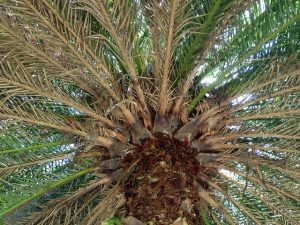Palm trees are a staple for many homes – they are absolutely gorgeous and not something that you can see everywhere. That is why so many people want to grow them. What they don’t realize, however, is that palm trees aren’t exactly easy to take care of in all situations. In fact, sometimes they can be downright difficult.
Whether you are interested in purchasing a palm tree sapling, you’ve moved into a home with a fully grown palm tree, or you are somewhere in between, you may have some questions about the care and maintenance of such amazing trees. Never fear, we are here to help.
Are Palms Really Trees?
- Heavily debated by professionals
- They are what you believe them to be
- You may need some added care, however
One of the biggest debates that you can find yourself in with a botanist is whether or not a palm tree is actually a tree. They lack the characteristics of secondary growth, which is the center of the arguments against them being a tree, according to Owlcation.
This means that there is not outward growth of the tree trunk, which is what gives the tree the rings that so many people love to count – especially in our area. Now, whether or not this is enough to disqualify them to the normal person is up for debate.
Most gardeners and tree care professionals will call a palm a tree, but some people will not at all. Some see it as its own category, others see it as a shrub, some even see it as a plant. Most people will say that it depends on the species – each one behaves quite differently.
What Do I Do If It Gets Too Cold?
- Palm trees are hardier than you’d expect
- Be careful about over nurturing your trees
- You do need to worry about elongated periods of cold
As the weather gets a bit colder, people almost immediately start to worry about their palm trees and whether or not the cold can impact them. It can, in extreme cases.
According to Garden Palms, one of the best approaches is to: “First wrap the leaf crown with garden fleece, if necessary twice, then wrap the trunk with bamboo mats. Tape the fleece overhang to the bamboo mats. Finally, cover the ground to about 50cm around the trunk with a generous mulch. Don’t over protect!”
As soon as the weather gets warm enough, you do want to remove that wrapping and allow the roots and trunk to breathe and dry out a bit if they were over saturated. While this isn’t usually a problem in or around Redwood City, we are experiencing more rainy and colder temperatures than we are used to, so it might be something you will have to consider moving forward.
How Much Should Palm Trees Be Watered?
- Depends on the variety
- Newer palms should be watered quite often
- Make sure that moisture penetrates the ground
If you are planting a palm tree sapling, you will need to water it at least twice a week for the first few months of life, according to BGI Fertilizers. You want to ensure that the water does get down into the ground about a foot and a half. You can use monitors to help you check the water levels. If the soil in your yard is sandy, you might have to water more frequently.
For palms that have been established, water will really depend on the climate, the season, and the weather. Make sure to monitor your soil and see how it feels. You may only need to water once or twice a month.
As always, you want to use your best judgment in planting palm trees and watering them. If you need help, it is best to seek out a professional.
How to Plant A Palm Tree
- Take your time to make the right selection
- Your soil matters
- Replace soil
If you have decided to take the leap and plant a palm tree, you might be nervous and unsure of what to do next. Certainly, you can have a professional help you with your tree care and planting, or you may elect to do it yourself. The one thing that you need to know is that how you plant your tree will determine how you take care of it into the future and how much work you will have to put into it all.
According to Gardening Know How, “Once you have your selection site, preparation is crucial to a healthy plant. Excessively alkaline soil should be amended with sulfur. The area should have organic nutrients over a large area since palm tree roots will spread and should have access to these nutrients many feet from the trunk. Take care not to bury the trunk in soil when planting a palm tree, as this could cause rot. Water the root ball before back filling the hole. Spread mulch several feet from the trunk out around the root zone to provide supplemental nourishment over time as it composts. Replace the mulch annually.”
Palm trees can be difficult, but they can also be great additions to your landscaping. They are absolutely beautiful and can really liven up your space. No matter where you have them, they will remind you of brighter days and better times. You do have to make sure that you put their care in the forefront of your mind, however.
If you are looking for a tree care professional in Redwood City, give Econo Tree Service a call today at (650) 200-2495. We will help you to better understand your trees and how to handle any watering, planting, pruning, or other tree issues that you may find – of course, we can also help you with other issues as well, including any seasonal tree care needs that you may have. We will provide you with the best possible tree service in the area, and provide you with real solutions that work.





